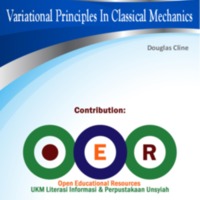Variational Principles in Classical Mechanics
Dublin Core
Subject
Description
The goal of this book is to introduce the reader to the intellectual beauty, and philosophical implications,
of the fact that nature obeys variational principles that underlie the Lagrangian and Hamiltonian analytical
formulations of classical mechanics. These variational methods, which were developed for classical mechanics
during the 18 th − 19 th century, have become the preeminent formalisms for classical dynamics, as well as for many other branches of modern science and engineering. The ambitious goal of this book is to lead the student from the intuitive Newtonian vectorial formulation, to introduction of the more abstract variational principles that underlie the Lagrangian and Hamiltonian analytical formulations. This culminates in discussion of the
contributions of variational principles to the development of relativistic and quantum mechanics. The broad
scope of this book attempts to unify the undergraduate physics curriculum by bridging the chasm that
divides the Newtonian vector-differential formulation and the integral variational formulation of classical
mechanics, and the corresponding chasm that exists between classical and quantum mechanics. Powerful
variational techniques in mathematics, that underlie much of modern physics, are introduced and problem
solving skills are developed in order to challenge students at the crucial stage when they first encounter this
sophisticated and challenging material. The underlying fundamental concepts of classical mechanics, and
their applications to modern physics, are emphasized throughout the course.
of the fact that nature obeys variational principles that underlie the Lagrangian and Hamiltonian analytical
formulations of classical mechanics. These variational methods, which were developed for classical mechanics
during the 18 th − 19 th century, have become the preeminent formalisms for classical dynamics, as well as for many other branches of modern science and engineering. The ambitious goal of this book is to lead the student from the intuitive Newtonian vectorial formulation, to introduction of the more abstract variational principles that underlie the Lagrangian and Hamiltonian analytical formulations. This culminates in discussion of the
contributions of variational principles to the development of relativistic and quantum mechanics. The broad
scope of this book attempts to unify the undergraduate physics curriculum by bridging the chasm that
divides the Newtonian vector-differential formulation and the integral variational formulation of classical
mechanics, and the corresponding chasm that exists between classical and quantum mechanics. Powerful
variational techniques in mathematics, that underlie much of modern physics, are introduced and problem
solving skills are developed in order to challenge students at the crucial stage when they first encounter this
sophisticated and challenging material. The underlying fundamental concepts of classical mechanics, and
their applications to modern physics, are emphasized throughout the course.
Creator
Contributor
Cut Rita Zahara
Rights
Creative Commons
Type
Files
Collection
Citation
Douglas Cline, “Variational Principles in Classical Mechanics,” Open Educational Resources (OER) , accessed October 17, 2025, https://oer.uinsyahada.ac.id/items/show/304.


